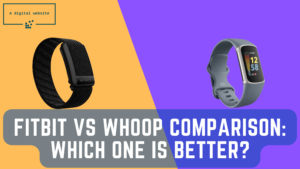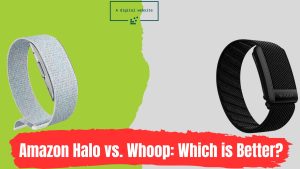Whoop vs Apple Watch: Which One is Better? Fitness trackers and smartwatches can help you stay fit and provide much information about your well-being that you might not otherwise know. Suppose you’ve recently been considering purchasing a fitness bracelet or watch. In that case, you’ve probably heard of Whoop and Apple Watch, two of the most well-known products in the wearable technology industry.
Most people consider the Apple Watch to be the holy grail of smartwatches, all because of its superior integration with the Apple ecosystem and flawless user experience. However, some may argue differently and claim that the new Whoop 4.0 is the best smart bracelet for tracking health and physical fitness.
The truth is that both have pros and cons, which means they cannot be compared on paper. For example, unlike Whoop, the Apple Watch has a large and bright display, but Whoop can operate for almost a week without recharging. One similarity between the wearable devices is that they can both sync data with the Apple Health platform.
So, the question arises – Which one to choose? To get to the bottom of this, we’ve delved into the Whoop 4.0 and Apple Watch Series 7, comparing them based on essential characteristics and much more in the most detailed comparison guide. Here’s how these two devices stack up.
Whoop vs. Apple Watch: Design
These two wearable devices differ significantly in terms of design and craftsmanship. Let’s start with the fact that the Whoop 4.0 is a basic tracker with main sensors on the back panel and does not have a screen, which means you need a smartphone to view any collected health and fitness data. They don’t even display the time and date, so they are far from traditional wristwatches in basic functionality.
For many, the absence of a screen on a fitness tracker may be a hindrance. However, for those who don’t want an additional screen on their wrist to look at, the Whoop strap should seamlessly blend into the design without protruding like a sore thumb.
On the other hand, Whoop offers a wide selection of accessory straps and undergarments for additional placement options beyond the wrist. Users can also swim, shower, or dive with the Whoop tracker, thanks to its IP68 protection class. It is dustproof and waterproof up to 50 meters.
Conversely, the Apple Watch Series 7 features an almost seamless OLED touchscreen display that becomes clear and bright enough to see in bright lighting. While not everyone may appreciate the Apple squircle design, it remains iconic and instantly recognizable. Furthermore, it preserves the beloved rotating digital crown and physical side button, offering users a delightful tactile navigation experience.
In the Series 7, as in its predecessors, premium-grade casing materials such as aluminium, stainless steel, and titanium are used, and users can choose from an extensive collection of straps from first and third-party manufacturers. The watches are available in sizes of 41mm and 45mm with support for GPS or GPS + cellular connectivity. You can purchase the watches in ten different case finish options: Midnight, Starlight, Graphite, Gold, Silver, Titanium, Space Black, Green, Blue, and Product Red.
Like Whoop, it is also waterproof up to 50 meters, so you can safely wear it while swimming or showering. However, it can only be worn on the wrist and nowhere else. In this sense, Whoop provides much greater flexibility.
Both devices, on their own, look good and are very comfortable to wear. However, most people may prefer a screen to see essential information without checking their phone. You might also like our other article comparing Amazon Halo and Whoop.
Whoop vs. Apple Watch: Fitness Tracking
The Apple Watch offers some of the most advanced fitness tracking features, including various modes for exercises, workouts, sports, and activities. It accurately tracks daily steps, runs, biking, and swims. Additionally, users can pair external heart rate monitors for more reliable data. The Apple Watch Series 7 seamlessly integrates with Apple’s Health app and Fitness+ platform, providing access to various fitness apps via the built-in App Store.
In contrast, Whoop’s sports tracking capabilities are limited despite targeting professional athletes. While it provides valuable data on the body’s response to long-duration workouts and intense training sessions, it lacks performance assessments of the actual sessions. The Whoop 4.0 tracker does not have GPS and relies on the phone’s GPS for tracking, which can sometimes lead to imprecise results. However, it can auto-detect specific workouts and exercises.
The new Whoop 4.0 features an improved HR sensor that collects biometric data to assess sleep, recovery, and strain scores. Unlike the Apple Watch, it offers the option to place the tracker on the bicep or use specialized apparel for more accurate readings. Whoop 4.0 integrates with Apple Health and Strava and has a companion Android and iOS mobile app.
For reliable activity and workout tracking with reasonable accuracy, the Apple Watch is the preferred choice. Whoop’s fitness tracking capabilities still have room for improvement to match the competition.
Whoop vs. Apple Watch: Health Tracking
Both devices offer comprehensive health monitoring capabilities. The Whoop tracker focuses on daily health stats and presents them in a streamlined scoring system, tracking resting heart rate, sleep quality, and fatigue to estimate recovery readiness for workouts. However, its presentation may seem less focused than other fitness trackers and smartwatches.
Whoop 4.0 features improved biometric hardware that records crucial health data 24/7, including heart rate, blood oxygen saturation level, respiratory rate, heart rate variability (HRV), and body temperature. It takes about two weeks to establish baselines and can predict the onset of common illnesses, though it lacks FDA approval.
The Apple Watch Series 7 boasts an FDA-approved ECG sensor for detecting irregular heart rhythms like atrial fibrillation (AFib) and provides abnormal heart rate alerts. It monitors blood oxygen saturation and breathing rate and tracks REM cycles during sleep. The ability to pair external health devices via Bluetooth enhances the Apple Watch’s capability to provide accurate insights into general well-being.
Access to the Apple App Store allows users to leverage additional health metrics, while Apple Health provides a detailed view of health and fitness data and allows for goal setting like the Whoop app.
Whoop vs. Apple Watch: Sleep Tracking
Sleep tracking is a key feature of the Whoop 4.0 tracker. Its detailed data graphs and high accuracy surpass those of devices like Fitbit, Garmin, and Oura. Whoop can assess how many hours of sleep you need, track your time in various sleep stages, and estimate the percentage of your nightly requirements. From the Whoop app, you can also access comprehensive information about your sleep sessions, including time spent in bed, disturbances, heart rate fluctuations, breathing rate, and more.
While the Apple Watch also offers sleep-tracking functionality, it is somewhat primitive compared to Whoop. You can download third-party sleep-tracking apps from the App Store for more detailed data, but they still need to gain the maturity and focus of Whoop’s sleep-tracking capabilities.
Whoop vs. Apple Watch: Software
Given that the Whoop 4.0 lacks a screen, the Whoop companion mobile app is the only user software. In the “Overview” monitoring panel, you can swipe to view strain, sleep, and recovery data. Swiping up reveals weekly data with detailed charts showing trends. The “Coaching” screen provides access to work reports, sleep coaching recommendations, health monitoring, and more. The app presents everything in a user-friendly format, suitable for the general public and healthcare professionals.
The official Whoop app is available for both Android and iPhone devices. In addition to the above, users can use the app to check battery life, set alarms, adjust tracker settings, and install firmware updates. The Whoop tracker itself lacks intelligent functions.
On the other hand, Apple Watch Series 7 runs on the watchOS operating system. While you’ll need an iPhone to access most of its features, doing so provides an unparalleled experience. The Apple watchOS platform has become more mature than ever, offering features like wrist notifications (with responses), Apple Music and Apple Pay support, cellular connectivity, customizable watch faces, built-in App Store, and more. It delivers everything you’d expect from a proper smartwatch and is a shining example of how wearable technology delivers consistent performance.
Additionally, Watch, Fitness, and Health apps on your iPhone complement the capabilities of the Apple Watch. The Watch app allows users to change watch faces, adjust settings, manage apps, and more. The latter two apps provide comprehensive health and fitness data, daily/weekly metrics, sleep information, past workouts and activities, and more. An Apple Fitness+ subscription unlocks additional workout types, audio/video guidance, real-time metrics, and more.
At the time of writing, Apple is testing the watchOS 9 Preview for the Apple Watch Series 4/5/6/7/SE. It introduces heart rate zones, sports performance metrics, running power, sleep stages, medication reminders, a revamped workout app with an expanded summary screen, and numerous new accessibility and performance features. Such improvements will further solidify Apple Watch’s lead over competitors.
Whoop vs. Apple Watch: Battery Life
In terms of battery life, the Whoop 4.0 is the clear winner. The absence of a screen or operating system significantly contributes to its ability to last up to five days between charges. You can charge the Whoop by attaching a tiny battery pack to it, meaning you won’t need to remove the Whoop to charge its battery. The battery pack itself can be charged via USB-C.
Apple Watch Series 7 claims to have an all-day battery life of up to 18 hours. However, depending on your usage pattern, they may last two days or less than the stated battery life. The magnetic charging cable lets you charge the watch in about 2.5 hours.
Whoop vs. Apple Watch: Verdict
For the vast majority, the Apple Watch, especially the Series 7, is likely the best choice for health and fitness monitoring. It boasts a premium look and provides advanced smart features and the overall watchOS platform from Apple is more versatile than any other wearable operating system on the market.
However, for serious athletes or fitness enthusiasts pushing their bodies to the limit and interested in accessing detailed data on sleep, strain, and recovery, Whoop 4.0 offers more valuable metrics. Additionally, its long battery life and unique charging pack ensure simplicity of maintenance and ease of use.
Of course, both the Whoop 4.0 and Apple Watch Series 7 come with a significant price tag, with Whoop even more so with its subscription-based model. The Apple Watch is a much better long-term investment if you’re not a fan of ongoing subscriptions.




